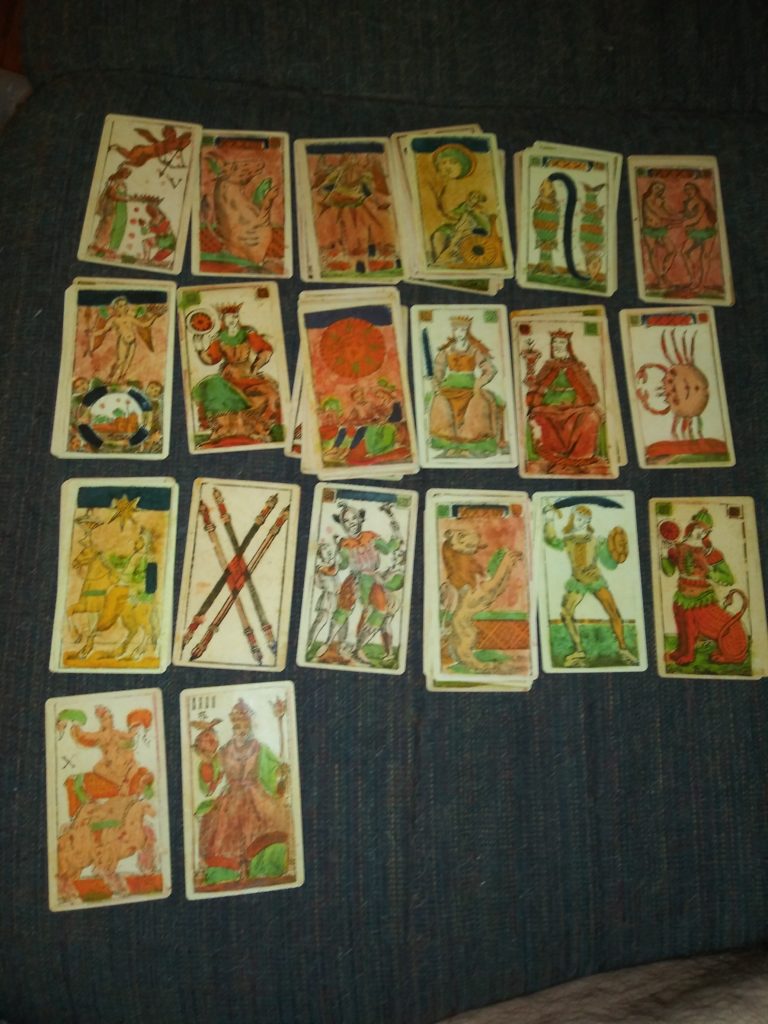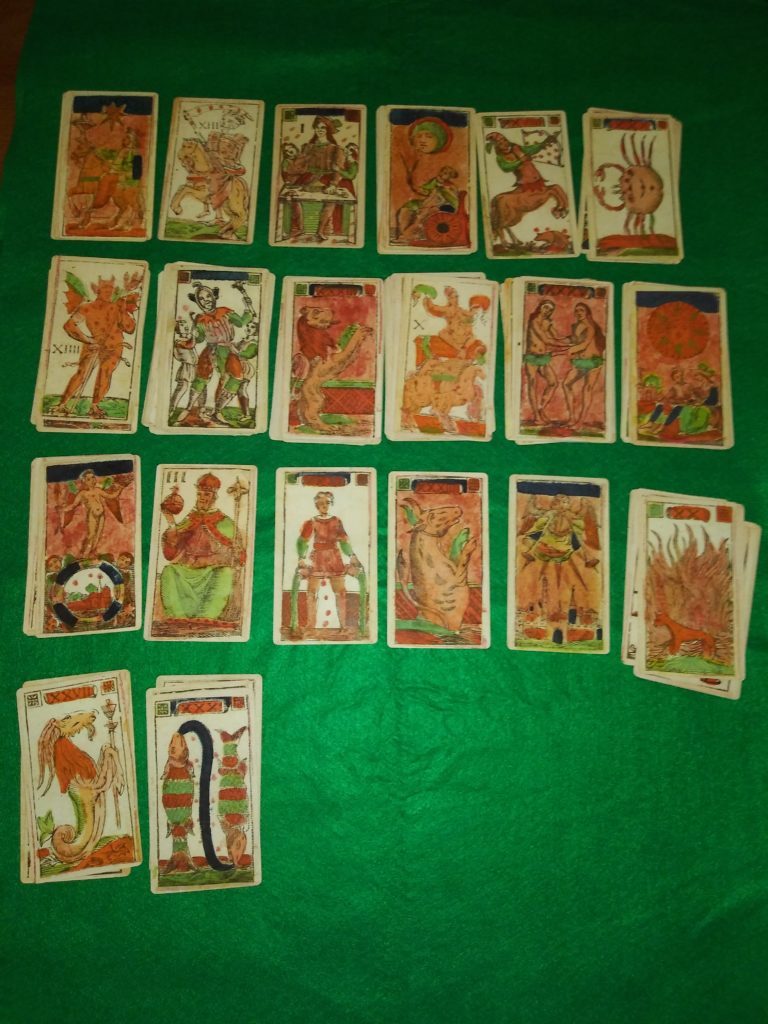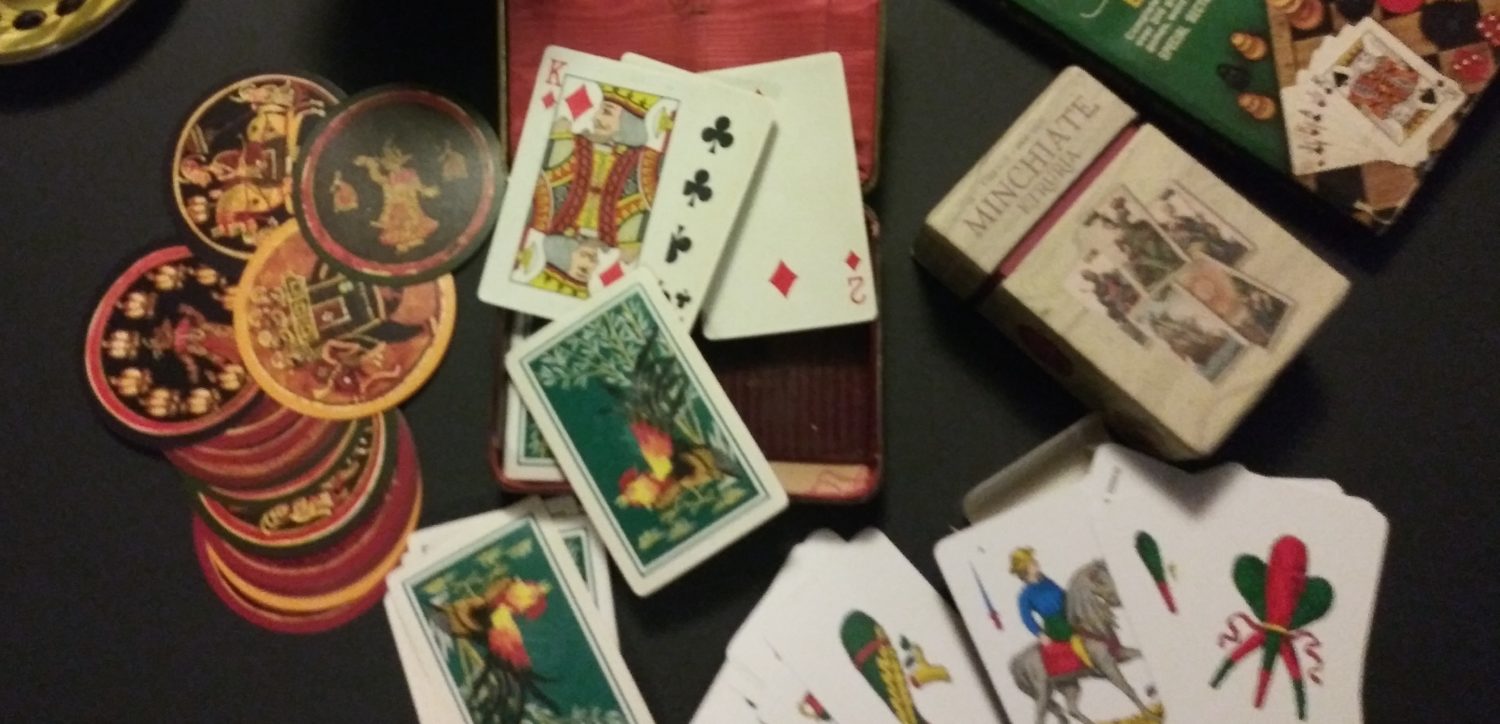©2019 Old-School Cards Club (https://oldschoolcards.club)
2019-04-16
Minchiate, also known as Germini, is a 500-year-old game played with a 97-card modified Tarot deck. For more information on Minchiate, see here. Minchiate Solitaire is a game invented by Dan Busenbarrick on March 24th, 2019. It is inspired by Minchiate and Accordion Solitaire, and uses the Minchiate deck.
Object
This game is scored, not merely won or lost. The object is to kill (cover up) cards that have a negative value and leave showing cards with maximum value.
The Deck
This is the standard 97-card Minchiate deck:
- The Cartiglie – four suits of 14 cards each.
- Tarot – A fifth suit of 40 cards.
- Il Matto (The Fool) – Neither cartiglie nor tarot.
Rules
Refer to the Minchiate Cheat Sheet for terms and definitions.
- Shuffle and Stacking the Fola
- Play begins by shuffling the cards then checking the bottom card. If this is a card of account, repeat the shuffle and check until the bottom card is no longer a card of account.
- Cut the cards by removing a packet of cards of any size from the top and placing it on the bottom.
- Deal the bottom 13 cards into a separate packet. This is the fola.
- Look at the cards in the fola and rearrange them any way you wish.
- Place the fola face-down outside the playing area. These will be the last cards played, and they may not be looked at again until that time.
- Main Play
- For the purposes of these rules, Il Matto is considered tarot with a numerical value of 0.
- The court cards have the following numerical values:
- King: 14
- Queen: 13
- Cavallo: 12
- Fante: 11
- Cards are played from the top of the face-down deck one at a time.
- A kill is made when a card pile is placed on top of a card pile to its left. The topmost card on the pile to the right is the killing card. The topmost card on the pile to the left is the dying card.
- A card that is played is laid face up, arranged into a grid of up to 24 piles (which may be one card), 6 piles wide by four piles high.
- Cards are played in rows left to right, with rows being played top to bottom.
- A card laid on top of another card forms a pile. The cards beneath the top card are no longer in play and are not kept visible.
- For purposes of determining the relative position of cards, each row of cards is considered to be to the right of the row higher. Thus, the last (sixth) card in the first row is considered to be one card to the left of the first card in the second row.
- A card may be played at any time so long as there are fewer than 24 piles. Once a 6 x 4 grid is formed, the grid is said to be full and no card can be played.
- A card may kill another card if the dying card is either 1 or 3 places to the killing card’s left and one of the following is true:
- The killing card and the dying card are both cartiglie and are the same suit.
- The killing card and the dying card are cartiglie, and their numerical value is the same.
- The killing card and the dying card are both tarot.
- The killing card is tarot, the dying card is a cartiglia, and the killing card has a numerical value of at least three times the numerical value of the dying card.
- When a kill is made, the space formerly occupied by the killing card is now filled by shifting any piles to the right of that space one position to the left.
- A kill may be made at any time.
- A kill is not compulsory.
- All cards must be played. If cards remain in the deck or the fola and the grid is full, a kill must be made in order to create space onto which a card can be played.
- Once all cards in the deck are played, the fola is taken in hand and used as the deck for the remainder of the game.
- Play is finished when all cards are played and all desired kills are made.
- Scoring
- Positive scoring is similar to Minchiate. Points from cards of account and versicole are counted from the cards atop the piles in the remaining grid, with exceptions listed here.
- Kings are not cards of account.
- There is no versicola of Kings.
- The versicola ‘Demonio, Mondo, e Carne’ (14, 39, 35) is valid.
- Sagittarius (29) counts as 5 points only in scoring a versicola. It is not a card of account and has no value on its own.
- If Sagittarius (29) is showing and cannot be included in a versicola, it counts as -10 points.
- The Devil (14) counts as 5 points only in scoring a versicola. It is not a card of account and has no value on its own.
- If The Devil (14) is showing and cannot be included in a versicola, it counts as -10 points.
- All cards showing that are not cards of account are scored with a negative value as follows:
- King: -50 points
- Queen: -40 points
- Cavallo: -30 points
- Fante: -20 points
- All other cards that are not cards of account: -10 points
- An unfinished game is scored as -300.
Strategy / Examples
- Kings are the enemy. A King is worth -50 points, and no tarot card can kill a King. They must, then, be killed by a lower card of the same suit, which can then be killed by a tarot with sufficient value. Much of the challenge in this game lies in killing cards to facilitate a King being one or three positions to the left of a card of the same suit, and doing so in such a way that eliminates a minimum of positive points.
- Stacking the fola is of critical importance. Of course, the cartiglie should be stacked such that cards of the same suit are adjacent, with cards of lesser numerical value played last. Ideally, a tarot card of account may be placed behind all the cartiglie so that they can all be eliminated. If there are sufficient tarot in the fola, it may also be a good idea to add a high tarot at the beginning of the fola in order to clear cards from a full grid.
This miserable game is the worst that the author has yet suffered. He desperately wishes he could have somehow preserved this shuffle so that he could try it again. Was it the shuffle or poor skill?

Versicole: 55
Non-Cards of Account: -190
Total: -44
This is the author’s current high score to date.

Versicole: 190
Non-Cards of Account: 0
Total: 303
